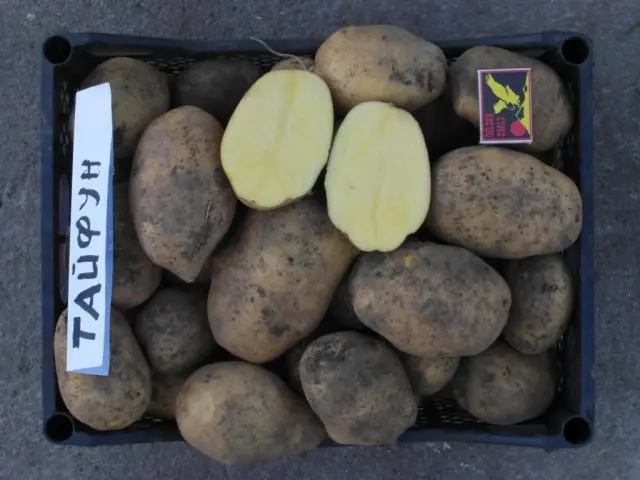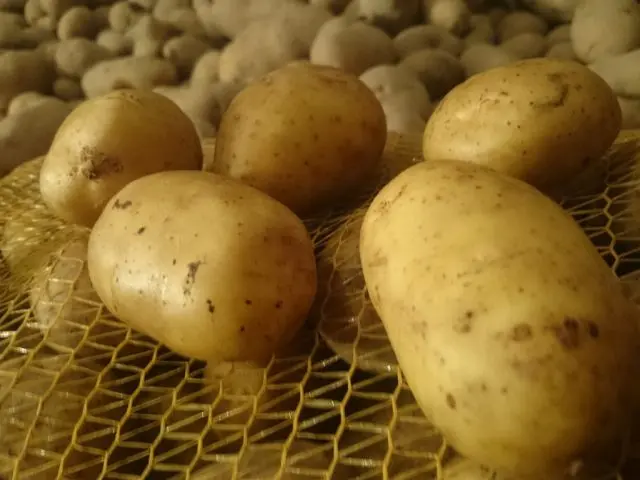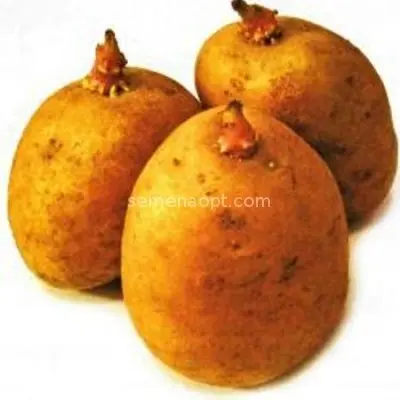Contents
When growing potatoes in areas where unstable weather conditions are observed, it should be borne in mind that the choice of planting material should be treated as responsibly as possible. Given the description of the Typhoon potato variety, photos and reviews, we can safely say that the culture of this variety is excellent for growing in regions with a variable climate. As a rule, it is recommended to grow a crop on the territory of Our Country, Ukraine and Moldova.

Description of the Typhoon potato variety
Breeders from Poland were engaged in breeding the Typhoon variety. For the first time, many gardeners paid attention to this variety in 2008, when the root crop was entered in the State Register.
If we consider the description of Typhoon potatoes, the following points can be distinguished:
- tubers are oval or rounded, slightly narrowed at the base;
- the peel is smooth, yellow;
- the pulp is quite juicy, the consistency is dense, in the context of a yellow or cream shade;
- the starch content is 16-20%;
- from each bush you can collect from 6 to 10 root crops.
Bushes in the process of growth reach a large size, the tops stand straight. It is worth noting that the plants are quite powerful, with a large number of rich green leaves. During flowering, large white flowers appear.
Taste qualities of Typhoon potatoes
Root crops of the Typhoon variety fell in love with many experienced and novice gardeners, not only because this species is unpretentious in care, but also due to its high taste qualities, which cannot be ignored.
This type of medium-early potato belongs to the table purpose. In the process of cooking, the root crops do not crumble and do not lose their shape, as a result of which potatoes are used to prepare a large number of dishes.
Pros and cons of the variety
Plants of the Typhoon variety, like most other species, have a number of advantages and disadvantages. If we consider the strengths of potatoes, then it is worth highlighting the following points:
- the culture has a high level of resistance to heat and dry weather;
- in the event that the bushes were damaged by frost or hail, a fairly quick recovery occurs, while this does not affect the yield and taste;
- tubers of the Typhoon variety do not crack during growth and maturation, are not prone to hollowness, growth;
- the level of keeping quality is quite high and amounts to 95%;
- excellent taste qualities of root crops;
- high level of resistance to many types of diseases and pests;
- low susceptibility to mechanical damage.
It should be noted that this variety has no significant drawbacks.
Planting and caring for Typhoon potatoes

As practice shows, to obtain a high level of yield, Typhoon potatoes should be properly cared for. Among the main activities for the care of plants are:
- timely hilling of potatoes, especially at the moment when there is an active growth of tops;
- weeds must be removed as soon as they appear;
- loosening of the soil;
- if there is a drought, then it is necessary to establish an irrigation system for the crop;
- throughout the season it is necessary to fertilize 2 times, especially if the root crops grow on poor soils.
To prevent the growth of weeds, it is recommended to mulch the soil.
Selection and preparation of the landing site
As you know, in order to obtain a high level of yield, it is necessary to first select and prepare a land plot. Judging by the characteristics and reviews, Typhoon potatoes can be grown on any soil.
Before planting a crop in open ground, it is recommended to dig up the selected land plot, carefully remove weeds along with the root system. In the event that the soil is infertile, it is worth fertilizing.
Preparation of planting material
Preliminary preparation of planting material can significantly increase the level of productivity. For processing root crops, you can use the following tools:
- growth stimulator – the composition includes trace elements, due to which the process of awakening the eyes is accelerated;
- drugs that prevent the occurrence of diseases – in this case, you can use a solution of copper sulfate, in which the tubers are dipped for 2-3 minutes;
- means protecting tubers from pests.
If necessary, planting material can be germinated.
Rules of landing
When carrying out landing work, you should adhere to the following rules:
- for growing potatoes of the Typhoon variety, it is recommended to choose black earth, sandy, loamy or peat lands;
- planting potatoes in open ground can be done at a time when the average daily air temperature outside is + 15 ° C. As a rule, potatoes are planted in the ground, warmed up to + 7 ° C, to a depth of 12 cm;
- landing work is carried out from April to May. The early planting process allows harvesting in the middle of summer. Young potatoes are eaten, and earlier root crops, which were planted in May, are used for storage;
- between bushes there should be a distance of up to 35 cm, the width between rows should not be less than 65 cm.
To obtain a high yield, it is recommended to plant Typhoon potatoes in areas where flax or lupins have grown before.
Watering and top dressing
If you follow all the agrotechnical rules in the process of growing typhoon potatoes, then it is worth considering that the crop should be irrigated once a week. As a result of the fact that potatoes are usually planted in large areas, they are watered once every 1-1 months. During the season, it is worth fertilizing at least 1 times, which will allow you to get a high yield.

Loosening and weeding
Weeding Typhoon potatoes is essential. The emerging weed interferes with the growth and development of tubers, as weeds take all the nutrients and moisture from the soil. As a rule, weed removal and soil loosening are carried out simultaneously with the hilling of potatoes. During the season it is recommended to remove weeds 3-4 times.
Hilling
With the help of hilling, you can retain moisture, get rid of weeds and protect the crop from possible frosts. In addition, it is important to understand that this procedure helps to increase yields, as there is an improvement in air circulation in places where tubers are poured. Potatoes spud each time after precipitation or watering.
Diseases and pests
Judging by the reviews and descriptions of Typhoon potatoes, the biggest problem in the growing process is the appearance of the Colorado potato beetle. In this case, it is recommended to use special preparations that are pre-diluted in water, after which the culture is treated. It is important to know that these insects do not like wood ash. That is why many gardeners sprinkle ashes on the land and potato bushes.
Potato yield
Typhoon potatoes are early maturing varieties. As you know, this type of crop is recommended to be grown in regions with unstable climatic conditions. The mass of one root crop varies from 50 to 150 g. As a rule, from 6 to 10 tubers can be collected from each bush.
Harvesting and storage
Since Typhoon potatoes are early ripe, harvesting can be started 65-75 days after planting material is planted in open ground.
It is worth noting that the principle of harvesting is no different from other potato varieties. A few weeks before they start harvesting, it is recommended to mow thick tops. It is recommended to collect potatoes in sunny weather.
Since potatoes have a high level of keeping quality, almost the entire crop can be sent for storage. The only thing that is required is to dry the potatoes in the sun, immediately remove the damaged fruits (some of them can be eaten), select the seed (it must be stored separately).
Conclusion
The description of the Typhoon potato variety, photos and reviews once again testify to the popularity of the culture. As you can see, root crops do not have significant drawbacks. They are excellent in taste, potatoes have a high and stable yield. It is necessary to grow and care for Typhoon potatoes in the same way as for a large number of other potato varieties, there is nothing complicated about this. This variety is perfect not only for experienced gardeners, but also for beginners.










